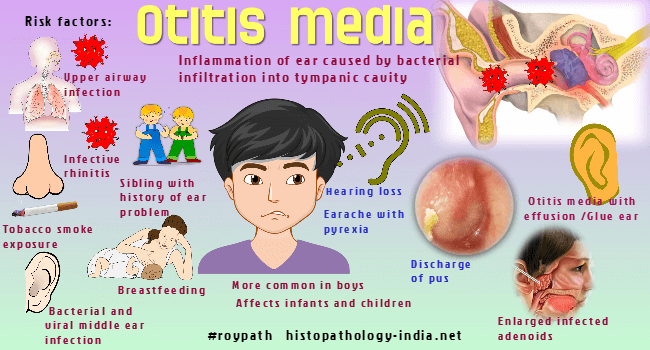|

Custom Search
|
|
Infectious Disease Online Pathology of Otitis Media
|

| Otitis media
is an inflammation of the ear that is caused by bacterial infiltration into
the tympanic cavity. It is a very common ear illness to young children.
Acute otitis media is secondary to an upper respiratory infection, and presents as severe prolonged earache with pyrexia and systemic illness. In some very acute cases, pus may discharge through a perforation before treatment can be started. Usually the eardrum is reddened in appearance. Acute mastoiditis is a serious complication of acute otitis media, but it can be treated successfully in most of the cases with broad spectrum intravenous antibiotics and myringotomy. Otitis media is likely to become a chronic disease if it is not proper treatment is in childhood due to frequent recurrences. Chronic otitis media means that there is a perforation of the eardrum. If the ear is constantly discharging scanty offensive pus through a posterior or superior perforation (unsafe type), modified radical mastoidectomy may be required, specially if cholesteatoma is present. A dry central perforation (safe type) which discharge intermittently with colds or swimming, is treated by antibiotic/steroid drops when wet, and may be repaired when dry by grafting of the eardrum if necessary with reconstruction of ossicular chain. Otitis Media with Effusion (OME), also known as “Glue Ear” or “Secretory Otitis Media”, has become an increasingly common disorder in children. It is an inflammatory condition of the middle ear cleft, acute or chronic, with collection of non-purulent fluid behind an intact tympanic membrane. It is the most frequent cause of hearing loss in childhood and the most common reason for surgery. OME is called chronic when the fluid persists for more than three months or when the episodes recur six or more times in twelve months. It usually affects those with recurrent otitis media and often enlarged infected adenoids, presumably because of poor Eustachian tube function. It is specially common in children with cleft palate as the muscles which open the tube have lost their insertion into the middle of the palate and atrophied. Inadequate antibiotics for acute infections is another possible cause. "Glue ear" is painless, and simply causes conduction deafness, of which it is the commonest cause in childhood. In some cases the appearances of the eardrum may be striking and include gross retraction, yellow or grey/blue discoloration and increased vascularity. Serous Otitis Media is usually found in adults and, in contrast with 'glue ear', the middle ear effusion is thin and watery. It causes conduction deafness. It may result from viral upper respiratory infection or from nasopharyngeal carcinoma (causes of Eustachian tube obstruction), or from barotrauma (sudden change in atmospheric pressure produced by flying or diving). Eosinophilic otitis media (EOM) is an intractable form of otitis media characterized by the presence of a highly viscous yellow effusion containing eosinophils. EOM shows a very high rate of association with asthma. It is resistant to conventional treatments for otitis media. However, EOM associated with adult-onset asthma has been shown to improve following optimal asthma therapy. EOM predominantly affects women in their fifties. |
|
|

